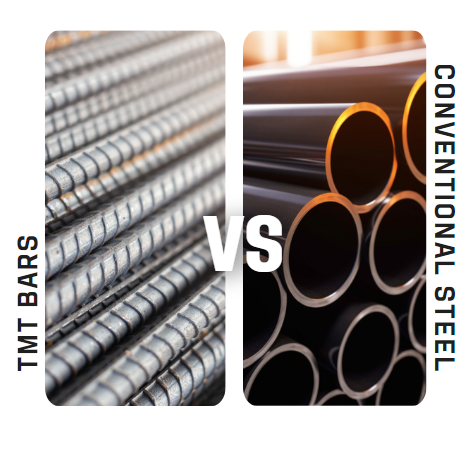Building Smart: How to Choose Between TMT Bars and Conventional Steel for Your Next Project
When planning a construction project, selecting the right materials is crucial to ensuring the structural integrity, safety, and cost-effectiveness of the build. Steel, being one of the most essential materials in construction, comes in various forms. Two popular choices are TMT (Thermo-Mechanically Treated) bars and conventional steel bars. Each type has its own set of advantages and applications. In this blog, we’ll explore the key differences between TMT bars and conventional steel, and provide guidance on how to choose the best option for your project.
Understanding TMT Bars and Conventional Steel
What are TMT Bars?
TMT bars are high-strength reinforcement bars known for their unique manufacturing process, which involves rapid cooling after the hot-rolling process. This results in a tough outer surface and a softer core, giving TMT bars their distinctive properties. They are widely used in construction due to their high yield strength, ductility, and resistance to earthquakes and corrosion.
What is Conventional Steel?
Conventional steel, often referred to as mild steel or plain carbon steel, has been the traditional choice in construction for many years. It is produced by adding carbon to iron, which enhances its hardness and strength. Conventional steel bars are commonly used for general reinforcement in concrete structures but lack some of the advanced properties of TMT bars.
Key Differences Between TMT Bars and Conventional Steel
Strength
- TMT Bars: Known for their high yield and tensile strength, TMT bars can withstand significant stress, making them ideal for high-load applications and high-rise buildings. Their yield strength typically ranges from 415 to 600 MPa.
- Conventional Steel: While still strong, conventional steel bars have a lower yield strength, usually between 250 to 350 MPa. This makes them suitable for smaller structures and projects with lower load-bearing requirements.
Flexibility and Ductility
- TMT Bars: The thermo-mechanical treatment process gives TMT bars excellent ductility and flexibility. They can bend without breaking, which is essential for absorbing and distributing stress, especially during seismic activities.
- Conventional Steel: Conventional steel bars are less flexible and more prone to cracking or breaking under extreme stress. This makes them less ideal for projects in earthquake-prone areas.
Corrosion Resistance
- TMT Bars: The manufacturing process of TMT bars includes a special treatment that enhances their resistance to corrosion. This makes them more durable in humid and coastal environments.
- Conventional Steel: More susceptible to rust and corrosion, conventional steel requires regular maintenance and protective coatings to prolong its lifespan.
Cost Efficiency
- TMT Bars: Although TMT bars may have a higher initial cost, their long-term benefits such as reduced maintenance, durability, and fewer material requirements make them cost-efficient in the long run.
- Conventional Steel: Typically less expensive upfront, conventional steel bars can lead to higher long-term costs due to more frequent maintenance, higher material usage, and potential structural issues over time.
Factors to Consider When Choosing Between TMT Bars and Conventional Steel
Project Type and Scale
- High-Rise Buildings and Large Structures: TMT bars are ideal for high-rise buildings, bridges, and other large structures that require high strength and flexibility.
- Low-Rise Buildings and Small Projects: Conventional steel can be a cost-effective choice for smaller, low-rise buildings and projects with lower structural demands.
Environmental Conditions
- Humid and Coastal Areas: TMT bars, with their superior corrosion resistance, are better suited for construction in humid and coastal regions.
- Dry and Mild Climates: Conventional steel can be used effectively in areas with dry and mild climates, where the risk of corrosion is lower.
Seismic Activity
- Seismic Zones: TMT bars are highly recommended for construction in earthquake-prone areas due to their ability to absorb and dissipate seismic energy.
- Stable Regions: In regions with minimal seismic activity, conventional steel can be a suitable and economical choice.
Budget and Long-Term Costs
- Initial Budget: If the initial budget is a major constraint, conventional steel might seem attractive due to its lower upfront cost.
- Long-Term Investment: For projects where long-term performance, safety, and reduced maintenance are prioritized, investing in TMT bars is more beneficial.
Practical Tips for Making the Right Choice
- Assess Project Requirements: Consider the structural load, environmental conditions, and seismic activity in the project area.
- Consult Structural Engineers: Engage with structural engineers to understand the specific demands of your project and get professional recommendations.
- Evaluate Cost-Benefit Analysis: Perform a cost-benefit analysis to compare the initial costs versus long-term savings and performance.
- Review Supplier Credentials: Ensure you are sourcing your materials from reputable suppliers who provide high-quality TMT bars or conventional steel.
Choosing between TMT bars and conventional steel is a critical decision that can significantly impact the safety, durability, and cost-efficiency of your construction project. TMT bars offer superior strength, flexibility, and corrosion resistance, making them suitable for high-demand projects and challenging environments. Conventional steel, while less advanced, can still be a viable option for smaller projects and less demanding conditions.
By carefully assessing your project’s specific needs and considering factors such as environmental conditions, seismic activity, and budget, you can make an informed decision that ensures the success and longevity of your build. Whether you opt for TMT bars or conventional steel, the key is to prioritize quality and suitability for your particular construction requirements

